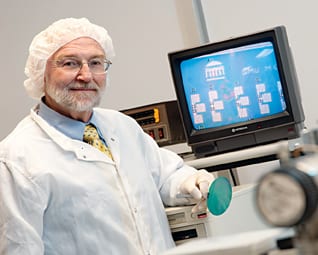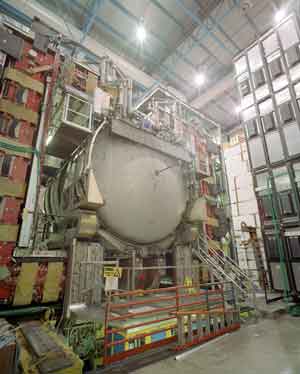 |
| Gary Evans in SMU’s Photonics Lab. |
Lasers have the potential to improve and revolutionize human lives in many ways, from consumer electronics and communications to medical equipment and homeland security. Helping unlock the barriers to these advancements is the research of SMU Electrical Engineering Professor Gary Evans.
Evans has been recognized by his peers for his contributions to the development, design and fabrication of semiconductor lasers, microscopic manufactured devices that can amplify subatomic light particles called photons.
This technology, in turn, can lead to applications that transmit data, energy, pictures or sound.
The field of photonics already has many claims to fame: Laser pulses deliver information through glass fibers to create the high-speed Internet; certain wavelengths of laser light are used in cancer therapy; lasers read CDs and DVDs; and at industrial plants, lasers cut materials with precision.
|
More SMU Research |
But future development of high-power applications requires research advancements of the kind Evans is tackling in his laboratory: He is looking for a way to fit billions of lasers and other optical components atop a microscopic chip.
The challenge is similar to the one faced in the late 1950s by the engineers who developed the electronic integrated circuit. The revolutionary high-density electronic integrated circuit paved the way for powerful hand-held calculators, laptop computers and myriad microelectronic devices and technology that have transformed the world.
Evans and other researchers believe photonic integrated circuits (PICs) may have that same vast potential, but there are technical problems to resolve. One key to manufacturing high-density PICs, which can hold billions of optical devices, is an “isolator.” An isolator would allow photons to flow unrestricted in the forward direction, but would prevent any reflected light from traveling backward. Without an isolator, unavoidable reflections would cause instabilities and chaos in the PIC.
“An isolator allows integration of large numbers of lasers and other optical components to produce stable, robust photonic circuits,” Evans says. Since 1994 he and Jacob Hammer, a retired colleague from RCA Labs, have been working along with graduate students to develop an isolator.
“We have a good understanding of the theory and we realize what problems need to be solved to make an integrated isolator in a semiconductor,” Evans says. “But more theory needs to be done to understand the materials that need to be developed. The materials just don’t exist yet.”
He is seeking federal funding to continue collaborations with Hammer, the University of California, Santa Barbara and the U.S. Naval Research Laboratory to develop those materials.
Since 2001 the team has received $250,000 in federal funding for isolator research. Some funding for Evans’ research also has been awarded to Photodigm Inc., a company he co-founded. Photodigm specializes in photonics technology for communications, digital imaging, defense and medical device applications. The Richardson-based company has contracts with the U.S. Department of Defense, among others.
Evans joined SMU in 1992, the year he also received one of electrical engineering’s top honors: election as a Fellow of IEEE, the technology industry’s professional association. The association cited Evans for contributions he has made to the industry’s development, fabrication and understanding of semiconductor lasers.
Over the years, Evans’ research has been conducted in conjunction with others, including the larger SMU photonics team: Jerome Butler, University Distinguished Professor of Electrical Engineering; Jay Kirk, SMU electrical engineering laboratory manager and a co-founder of Photodigm; and Marc Christensen, chair and associate professor of the Electrical Engineering Department and a member of Photodigm’s technical advisory board. — Margaret Allen
Related links:
Gary Evans
Jerome Butler
Jay Kirk
Marc Christensen
SMU Photonics Group
The Daily Campus: Shade Tree Engineering
SMU’s Electrical Engineering research
Department of Electrical Engineering
Photodigm
Bobby B. Lyle School of Engineering



